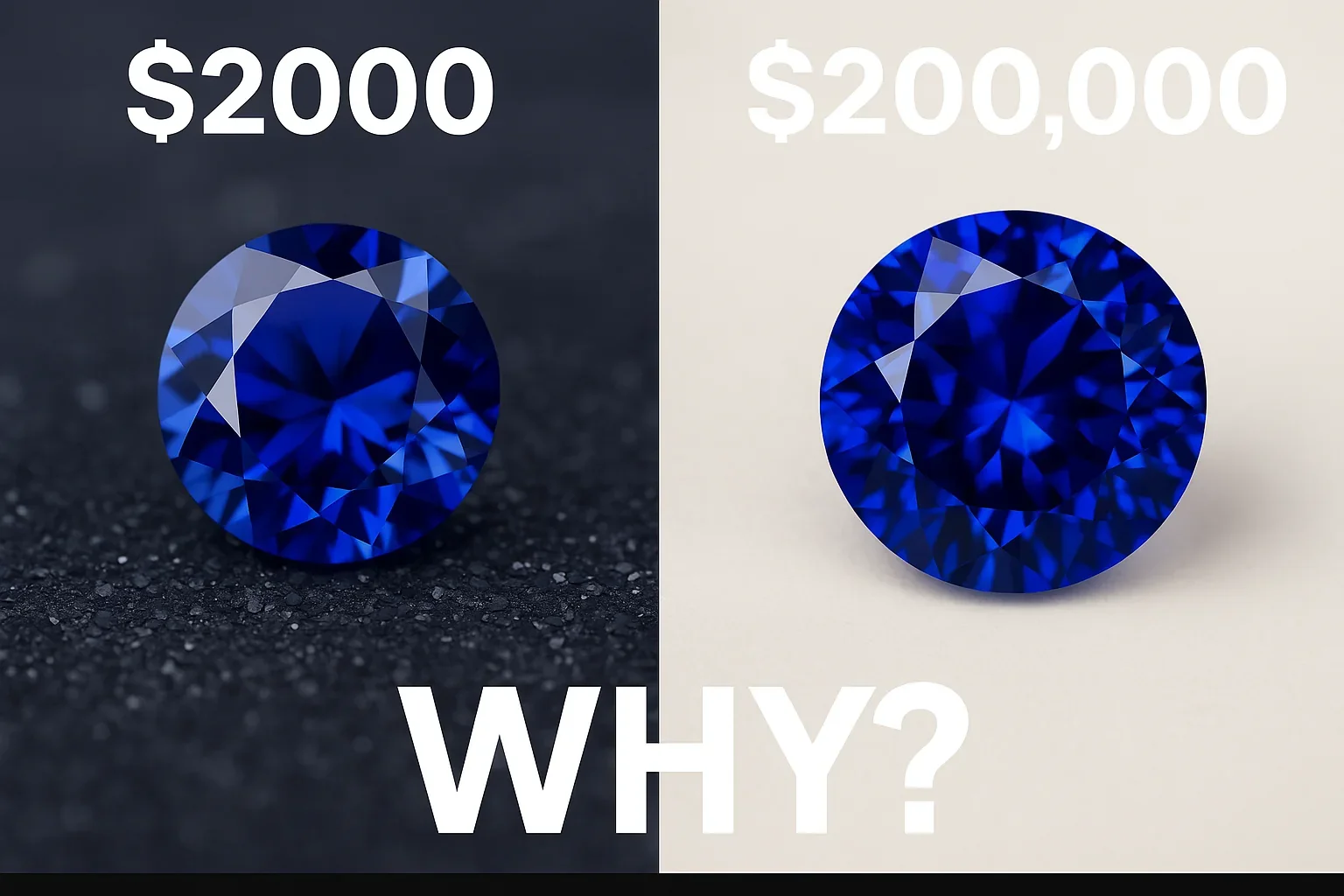$2,000 or $200,000: What Really Determines the Price of a Gemstone
“Two stones can shimmer the same shade of blue, yet one carries the sky while the other only its reflection.”
A Question Every Jewellery Buyer Asks
When clients begin exploring fine jewellery, one question almost always arises: Why do gemstones that look so similar vary so much in price?
A sapphire engagement ring in one store might cost two thousand dollars, while another, nearly identical in design, sells for twenty thousand or even two hundred thousand. To the untrained eye, the difference can feel mysterious.
Recently, a client visited our Auckland design studio with exactly this question. He had compared sapphire engagement rings from several jewellers and was puzzled. The designs were nearly identical, the carat weights the same, yet the prices spanned entire worlds.
At Layaz, we welcomed his curiosity. Education is the heart of what we do. We placed several sapphires before him under natural light and explained what truly defines a gemstone’s worth. By the time he left, he no longer saw just sparkle; he saw story, rarity, and authenticity.
That experience inspired this article, written to help anyone understand the hidden language of gemstones and what makes one stone priceless while another is simply beautiful.
The Essence of a Gemstone’s Value
Every gemstone begins deep within the earth, shaped over millions of years by heat, pressure, and chemistry. It emerges not as a product but as a miracle of time.
A gem’s value is the balance of beauty, rarity, and authenticity - qualities that cannot be duplicated by machines or measured only in carats.
At Layaz, we often say that two sapphires can share a colour but not a soul. Their formation, clarity, and craftsmanship are what set them apart.
Pillars That Shape Gemstone Pricing
1. Origin: Where Beauty Begins
Just as wine draws character from the soil, gemstones inherit theirs from their birthplace.
Sapphires from Ceylon (Sri Lanka) are renowned for their luminous cornflower blue tone, a vivid yet open hue that glows in natural light. Stones from Madagascar can also display remarkable colour but may lean slightly cooler, while sapphires from Thailand or Africa often appear darker or inky under certain lighting.
Origin influences not only appearance but heritage. A Ceylon sapphire carries centuries of royal association and reputation for purity, adding value beyond what the eye can see.
2. Colour: The Soul of a Stone
Colour is the single most important factor in determining price. In sapphires, tone and saturation define brilliance far more than size.
A $2,000 sapphire may appear pale or uneven, lacking intensity.
A $20,000 sapphire holds depth and vibrancy, its hue alive under any light.
A $200,000 sapphire, like an exceptional Ceylon stone, radiates a royal blue so vivid it seems to hold light within.
Even small changes in saturation can shift value dramatically. A fine sapphire glows; it does not merely sparkle.
Beyond Blue: The Many Colours of Sapphire
While blue sapphires remain iconic, sapphires are found in an extraordinary spectrum of colours each with its own beauty and personality.
Teal sapphires, blending blue and green, are now among the most sought-after choices. Their shifting tones from oceanic blue to forest green feel modern yet timeless.
Pink sapphires express romance and warmth, their blush tones reminiscent of sunrise light. Some approach ruby-like intensity, offering vivid alternatives for those who want passion without red’s depth.
Yellow sapphires glow with golden radiance, ranging from delicate lemon to honey hues joyful, luminous, and contemporary.
Green sapphires, understated yet elegant, exude calm individuality. Their cool hues pair beautifully with gold or platinum, creating jewellery that feels organic and refined.
Each colour follows the same principles of tone, saturation, and clarity that define blue sapphires. The most valuable examples show purity of colour vibrant yet balanced, bright but never harsh.
At Layaz, we remind clients that choosing a sapphire is deeply personal. Rarity may affect price, but connection defines value. Whether classic royal blue or the modern teal, the right stone is the one that feels like your story captured in colour.
3. Clarity: The Window to Purity
Every natural gemstone bears inclusions: tiny fingerprints of its creation. They prove authenticity.
The fewer and finer these inclusions appear, the greater the transparency and brilliance.
A heavily included sapphire can appear cloudy.
A fine sapphire remains luminous and clear even under magnification.
Perfection is rare. The goal is harmony - a gemstone that reflects light effortlessly while retaining its natural character.
4. Cut: Where Art Meets Science
Cut determines how light moves through the stone. Even the most exquisite colour can appear dull if the cut is shallow or uneven.
The sapphire our client first brought in had a wide face and shallow base that allowed light to leak through. It looked large but lacked life. When we placed beside it a smaller, precisely cut gem, the difference was instant - the smaller stone glowed from every angle.
A masterful cut transforms potential into brilliance. At Layaz, we see cutting not as a mechanical process but as sculpture in light.
5. Rarity and Carat Weight
Rarity outweighs size. A smaller sapphire with exceptional colour can command a higher price per carat than a larger one of average tone.
Fine sapphires of vivid hue are scarce even in small sizes. Once a gem exceeds three or four carats with perfect colour and clarity, its price climbs exponentially. A perfectly proportioned ten carat sapphire of pure tone and transparency is a once-in-a-lifetime discovery.
The Layaz Story: Understanding Real Value
Our client’s confusion over sapphire prices was not unusual. Many buyers assume identical designs mean identical stones.
We placed three sapphires before him on a velvet tray.
The first, lighter and uneven, looked pleasant but flat. Its pale tone explained the lower price.
The second, a deep royal blue with crisp facets and strong clarity, drew attention immediately.
The third, a rare Ceylon sapphire, seemed to hold light itself: vivid, silky, and harmonious. Even before learning its value, he sensed its rarity.
We explained that price reflects measurable qualities: colour, clarity, cut, and scarcity. Seeing them together, he finally understood why one sapphire might cost ten times another and why true value lies in quality, not size.
He left with a smile and a deeper appreciation for the art behind every gemstone and for us, that understanding is worth more than any sale.
Why Transparency Matters
Transparency defines trust. At Layaz, every conversation begins with education. We show clients how light interacts with each stone and explain the subtleties of hue and proportion.
Every gemstone we source follows ethical practices through the Responsible Jewellery Council (RJC). Each is carefully selected for its natural beauty and integrity.
Knowledge transforms uncertainty into confidence, and confidence transforms a purchase into a lifelong heirloom.
Beyond Sapphires: Emeralds and Rubies
Though sapphires are our signature, the same principles of colour, clarity, and saturation shape the value of emeralds and rubies.
Emeralds are prized for their lush green hue, the colour of life and renewal. The finest examples glow with balanced saturation, not too dark or too pale. Because emeralds often carry natural inclusions, a clean stone with vibrant colour is exceptionally valuable. The legendary Colombian emeralds embody this rare harmony.
Rubies owe their fire to saturation. The ideal ruby shows a pure, vivid red that seems to burn from within. When the tone drifts toward pink or brown, value decreases. High quality rubies shine with depth and brightness, symbols of passion and rarity.
Understanding these nuances helps clients see beauty not just on the surface but within the gem’s structure, an understanding that transforms admiration into knowledge.
The Value of Authenticity
In a world filled with synthetics and imitations, authenticity has never been more precious.
A natural gemstone carries imperfections that prove its creation by the earth. These subtle variations are its signature. Lab-created stones may mimic perfection, but they lack history, emotion, and permanence.
Owning a natural sapphire or emerald is holding a piece of the planet’s story, a moment of geological artistry chosen for its individuality.
At Layaz, authenticity is our promise. Each gemstone is natural, ethically sourced, and hand-selected. Our clients invest not in trends but in timeless pieces that carry meaning through generations.
The Layaz Perspective
For three generations, our family has refined the craft of jewellery making. We have learned that brilliance is never accidental, it comes from respect for both nature and art.
Our bespoke jewellery process pairs each gemstone with a design that enhances its individuality. In our Auckland design studio, clients collaborate directly with our designers, bringing their vision to life.
Through Heirloom jewellery redesign, we renew older pieces: polishing stones, refining metals, and honouring memories sustainably. Every creation is where heritage meets innovation, passion meets precision.
Our purpose is simple: to help each client understand the quiet language of gemstones so that every choice is guided by knowledge and love of craft.
A Final Thought
Two gemstones may look alike, but their journeys through time make them incomparable. One may hold colour born of perfect balance, the other light dulled by imperfection.
The next time you compare price tags, remember that value is not in the number but in the nature of the stone.
At Layaz New Zealand, we invite you to discover this for yourself. Because the most beautiful gemstone is not the one that shines the brightest, it is the one that speaks to you.


